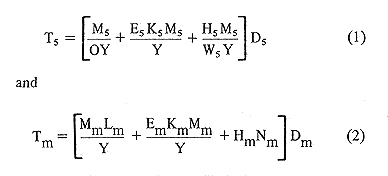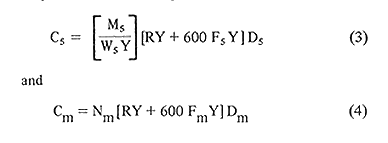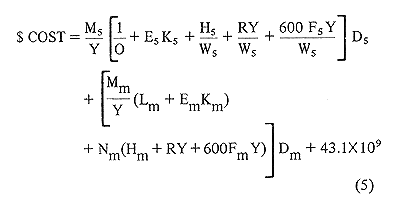
SPACE COLONIZATION COST PARAMETRICS
The simple, analytic expression used for estimating the costs of space colonization versus time is particularly useful as an aid in observing the effects upon costs due to variations in the system parameters. Moreover, it is formulated on a rate basis so that the results can be scaled as the technologies or strategies of colonization change. However, the equation cannot be used indiscriminately without regard to several precautions. The equation only models the system costs, giving approximate results. When the cost equation is placed on a rate basis it is assumed that the system costs scale linearly. To simplify the equation, a number of terms which were thought to be negligible or too difficult to formulate were omitted, hence the results are too low. The 20 percent overhead charges were explicitly omitted. Finally, it is not easy to include parameters which change from year to year during the colony build up. In spite of these shortcomings, this equation is quite useful as a means of sensing cost trends which accompany changes in system parameters.
The major cost factors include research and development (R&D), production, transportation, and crew costs for the L5 and lunar facilities. The other costs in the system have been neglected. An analysis of the R&D and production costs shows them to be relatively independent of modest variations in size. Data from table 6-9 show these costs to be $28.5 X 10^9 and $14.6 X 10^9, respectively, for a total of $43.1 10^9. Transportation costs to L5 and the Moon are expressed as

where all parameters of the system are defined and evaluated for the baseline system in table 6-10.
TABLE 6-10 (gif format)
| Symbol | Units | Definition | Baseline magnitude |
|---|---|---|---|
| M5 | kg | Mass of Al in L5 habitat | 5X10^8 |
| O | kg/kg/yr | Ratio of L5 plant output/yr to plant mass | 8.3 |
| E5 | kg/kW | Specific mass of L5 power plant | 14 |
| K5 | kW/kg/yr | Power required per unit mass of Al produced at L5 | 2.2X10^-3 |
| W5 | kg/person-yr | Productivity of L5 workers | 46X10^3 |
| F5 | yr^-1 | Crew rotation rate for workers at L5 | 1 |
| H5 | kg/person | Mass of L5 construction shack/person | 5X10^3 |
| D5 | $/kg | Launch costs to L5 | 800 |
| R | kg/person-yr | Re-supply rate for workers | 1.7X10^3 |
| Mm | kg | Mass to be launched from Moon | 1.2X10^10 |
| Lm | kg/kg/yr | Ratio of launcher mass to mass launch rate | 4.6X10^-3 |
| Em | kg/kW | Specific mass of lunar power plant | 45 |
| Km | kW/kg/yr | Power required per unit mass launched from Moon | 2X10^-4 |
| Hm | kg/person | Mass of lunar crew habitat/person | 7X10^3 |
| Fm | yr^-1 | Crew rotation rate for workers at Moon | 0.5 |
| Nm | persons | Number of crew on Moon | 150 |
| Dm | $/kg | Launch costs to Moon | 1600 |
| Y | yr | Duration of the project - 8 yr | --- |
Note - Y is not the duration of the project, but 8 yr less.

When these results are added together, the total cost in 1975 dollars is obtained as

When the baseline values of the parameters from table 6-10 are substituted into eq. (5), the result is

These results are shown in figure 6-7. To demonstrate the use of the cost equation, two additional examples are also shown in the figure. In the first, a more advanced transportation system is considered which has $9 X 10^9 additional development costs, but which reduces the launch costs per kg to L5 and the Moon to $200 and $400, respectively. The cost equation for this case is

In the second, a solar power source, instead of the nuclear source, is used on the Moon with a resulting cost equation of

Note that in the second case, this change is merely a convenient one for showing the use of eq. (5) and does not consider any of the related technical problems.
Specific ideas to optimize the system include: